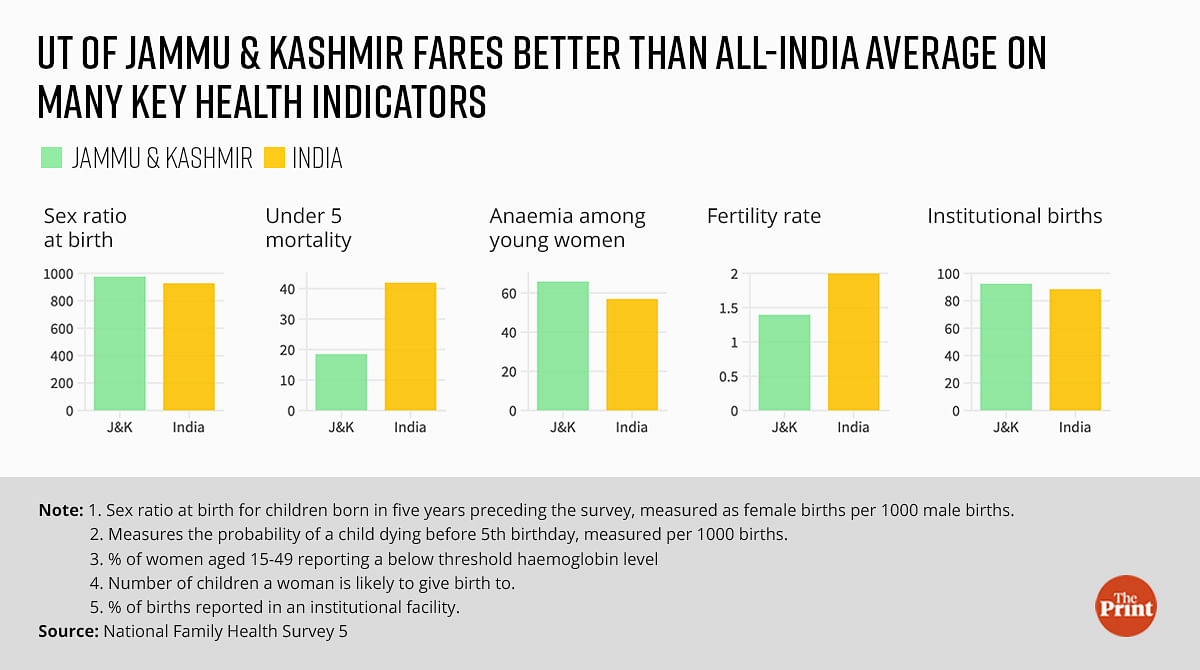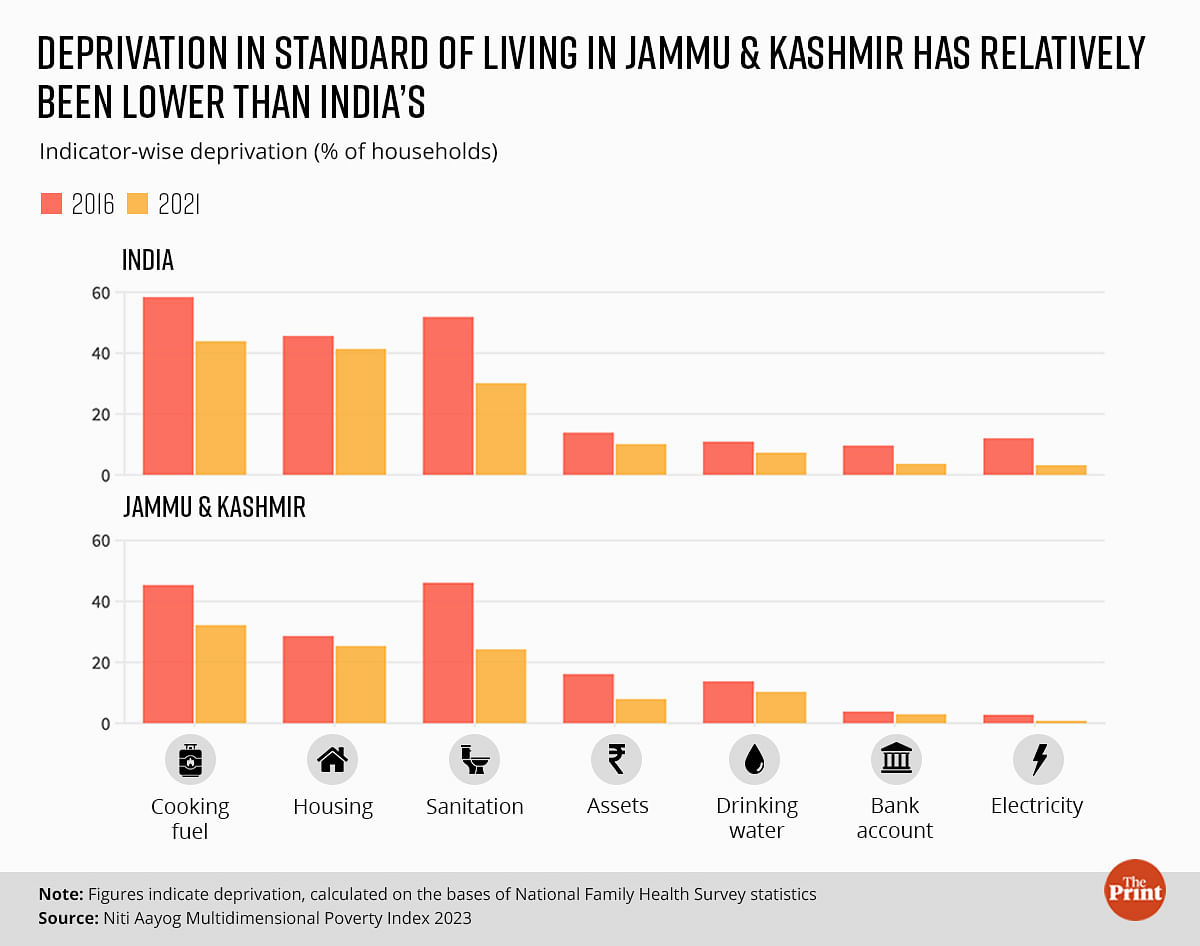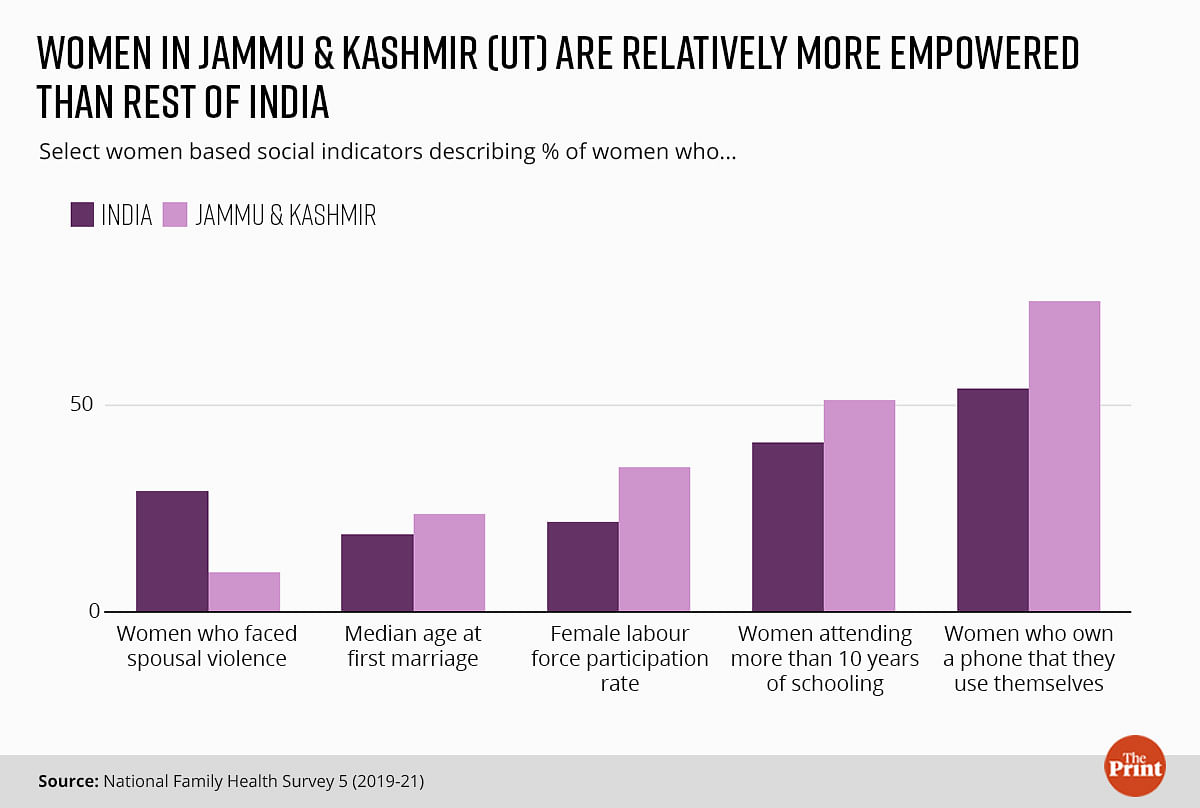New Delhi: Decades of conflict notwithstanding, Jammu & Kashmir seems to be doing better than India on key socioeconomic indicators like healthcare, women empowerment and education, government data shows.
This August marks four years since the abrogation of Article 370 — which gave a special status to the erstwhile state of Jammu & Kashmir.
On this occasion, ThePrint looked at government data on the ground reality in J&K and found that the erstwhile state beats the all-India average on several key parameters such as child sex ratio and women’s education.
The data also shows how Muslims of the region defy the stereotypes often associated with them.
Talking about J&K’s performance on these indicators, experts on the region suggest that it is nothing new.
Social welfare and focus on healthcare and education has been the cornerstone of governance in J&K since the mid-20th century, they say.
Also Read: Kashmir sees ‘drastic fall’ in terror recruitment after Army & police launch de-radicalisation drive
Healthcare
ThePrint scanned five health indicators from the National Family Health Survey-5 (NFHS-5, conducted in 2019-21): Sex ratio at birth, under-five mortality, percentage of institutional births, fertility rate, and percentage of young women facing anaemia.
Jammu & Kashmir fared better than the all-India average on four of them.

Sex ratio at birth — measured as a ratio of females born per 1,000 males in the five years preceding the survey — was 976 for J&K, against 929 for India. This means that for every 1,000 male children born, J&K reported 47 more female births on average than all of India.
The share of children who do not live up to their fifth birthday — or under-five mortality — is also lower in J&K at 18.5 per 1,000 births. At 42, the all-India average is over two times that of J&K.
The total fertility rate, which measures the average number of children a woman is likely to have in her reproductive life, was 2 for India (replacement rate), and 1.4 for Jammu & Kashmir.
For every 100 women, this suggests, the UT reports about 60 fewer births than the all-India average.
Also, there is a greater likelihood of women giving birth in institutional facilities — for example, a hospital or clinic — in J&K.
About 92.4 percent of the women surveyed delivered their babies in an institutional facility against the all-India average of 88.6 percent.
Only in terms of the share of women suffering anaemia does the UT rank below the national average. More than 65 percent of women in the 15-to-49 age group reported a below-threshold level of haemoglobin. The national average is 57 percent.
Standard of living
The latest round of NITI Aayog’s Multidimensional Poverty Index 2023, which measures deprivation beyond the income criterion, outlines seven indicators for measuring standard-of-living deprivation — access to clean drinking water, improved sanitation facilities, cleaner cooking fuel, housing, electricity, assets, and bank accounts. Except access to clean drinking water, the deprivation on all indicators was lower for Jammu & Kashmir than the all-India average.

In terms of cleaner cooking fuel, the deprivation stood at 32.3 percent for J&K’s population, compared to 44 percent for all of India. Less than a fourth — 24.2 percent — of J&K residents face deprivation in terms of improved sanitation facilities, against 30 percent across India.
More than 99 percent of the homes in Jammu & Kashmir have electricity — slightly better than the all-India average of 96.8 percent. Housing deprivation (% of people living in a house with flooring made of “natural material”, or a rudimentary roof) was 25.36 percent for J&K, against the all-India average of 41.37 percent. Banking and asset deprivation was also relatively lower (see chart).
However, when it comes to access to clean drinking water, J&K fares worse than the rest of the country — 10.37 percent of J&K residents still have to walk more than 30 minutes to access drinking water, against a national average of 7.3 percent.
More empowered women
In Jammu and Kashmir, more than 51 percent of women (aged 15-49) said they had attended school for more than 10 years, according to the NFHS-5. The all-India average was 41 percent.

Longer schooling is known to reduce the chances of women being married off early. The median age at which a woman (respondents aged 25-49) in Jammu Kashmir got married is 23.6 years, against 18.8 at the all-India level.
The share of women in the workforce is also relatively higher in Jammu and Kashmir. According to the latest round of the annual Periodic Labour Force Survey (2021-22), which measures the employment situation in the country, about 35 percent of women in Jammu and Kashmir were either working or looking for work. The all-India average was 21.7 percent.
More women in J&K also own a mobile phone that they use themselves — 75 percent — against the national average of 51 percent.
In another key indicator, a lower share of women in J&K said they had faced spousal violence — 9.6 percent — compared to 29.3 percent countrywide, according to NFHS-5.
Defying stereotypes
J&K (pre-bifurcation) was a Muslim-majority state.
According to Census 2011, which includes data for Ladakh, Muslims form about 68 percent of J&K’s population.
However, the demographic indicators for J&K Muslims are significantly different from those for Muslims in the rest of the country.
The total fertility rate for a J&K Muslim woman, according to the NFHS-5, was 1.45, against 2.36 for Muslims around India. This means that 100 J&K Muslim women were likely to give birth to 91 fewer babies than as many Muslim women across India.

J&K Muslim women also expressed a desire to have fewer children. The self-reported desired number of children translated to a ‘wanted fertility rate’ of 1.31 for J&K Muslim women, against 1.8 among Muslim women across India on average.
The practice of polygamy is rare in India, but is a common stereotype associated with Muslims.
According to a study published by the Mumbai-based Indian Institute of Population Sciences, 1.4 percent of Indian women said their husbands had more than one wife, compared to 1.9 percent for Muslims alone.
For J&K Muslims, the figure was 0.5 percent.
‘Key lies in J&K economic history’
According to Professor Noor Ahmad Baba, who retired from Kashmir University and is an expert on the local socioeconomic situation, the foundation of Kashmir’s development was laid long back.
“In 1944, the National Conference (NC)… manifesto… made social justice, parity, women empowerment and human development the leitmotif of its politics,” he said.
“In 1947, when India attained Independence, the likelihood of achieving these became a possibility as the leaders then believed Kashmir would progress with the accession to the Indian side,” he told ThePrint.
“Kashmir got the special status and it became India’s first state to introduce land reforms,” he said. “It ended the feudal lord system, distributed land among peasants, which laid the foundation stone for parity. Land in Kashmir is also of good quality for it yields greater monetary benefits, hence everyone has access to resources.”
According to an analysis by Haseeb Drabu, former J&K finance minister, this is visible in data. In an opinion piece written for business daily Mint immediately after the abrogation of Article 370, he said rural income disparity in J&K was low, and so was the level of indebtedness.
“The economic enfranchisement of the poorest in J&K is borne out by the near-absence of landless labour; less than 2 percent of the workforce are agricultural labourers. The all-India average for the incidence of agricultural labourers is 23 percent,” he wrote.
The level of economic empowerment, Drabu said, “is evident from the fact that more than 25 percent of the household earnings in J&K are from own cultivation”.
“In ‘prosperous’ Punjab, it is only 18 percent, in ‘vibrant’ Gujarat, it is less than 16 percent, and in ‘terrific’ Tamil Nadu, it is only 3 percent. And yet, J&K is being portrayed as a ‘sick’ state,” he wrote.
Baba said the NC’s investments in education and healthcare helped in achieving development early.
“The government in Kashmir, thanks to their politics, pumped a lot of money into the education and health sector. So, the socialist politics of the state in the past had a long-term impact on its developmental outcome.”
Due to the historic value of Kashmir’s handicrafts industry, which is majorly based in rural areas, the disparity between rural and urban areas is also low, he said.
“Kashmir’s handicrafts are of high quality, high monetary value. It also employs women and lets them earn money for a comfortable lifestyle. It is rare to find people sleeping on the streets in Kashmir, the way you would find in other parts of the country,” Baba said. “From experience, I can say that higher growth and development leads to family planning and the lower fertility rates might be explained by Kashmir’s economic transition.”
(Edited by Sunanda Ranjan)
Also Read: Abrogation of Article 370 ‘death of democracy as it was done without consent of state’: Digvijaya



